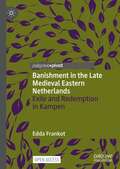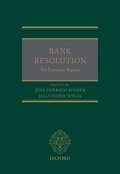- Table View
- List View
Ban This Filth!: Letters From the Mary Whitehouse Archive
by Ben ThompsonIn 1964, Mary Whitehouse launched a campaign to fight what she called the 'propaganda of disbelief, doubt and dirt' being poured into homes through the nation's radio and television sets. Whitehouse, senior mistress at a Shropshire secondary school, became the unlikely figurehead of a mass movement for censorship: the National Viewers' and Listeners' Association, now Mediawatch-uk.For almost forty years, she kept up the fight against the programme makers, politicians, pop stars and playwrights who she felt were dragging British culture into a sewer of blasphemy and obscenity. From Doctor Who ('Teatime brutality for tots') to Dennis Potter (whose mother sued her for libel and won) to the Beatles - whose Magical Mystery Tour escaped her intervention by the skin of its psychedelic teeth - the list of Mary Whitehouse's targets will read to some like a nostalgic roll of honour.Caricatured while she lived as a figure of middle-brow reaction, Mary Whitehouse was held in contempt by the country's intellectual elite. But were some of the dangers she warned of more real than they imagined? Ben Thompson's selection of material from her extraordinary archive shows Mary Whitehouse's legacy in a startling new light. From her exquisitely testy exchanges with successive BBC Directors General, to the anguished screeds penned by her television and radio vigilantes, these letters reveal a complex and combative individual, whose anxieties about culture and morality are often eerily relevant to the age of the internet. 'A fantastic read . . . I can't recommend it highly enough.' Lauren Laverne, BBC Radio 6 Music
The Banana Dispute: An Economic and Legal Analysis (Europainstitut Wirtschaftsuniversität Wien Schriftenreihe Europainstitut Wirtschaftsuniversität Wien Publication Series #19)
The "Banana dispute” represents one of the central cases in international trade. It has led to several precedents on the international (WTO), EC and national level. It thus constitutes the mandatory starting point for any in-depth study of the WTO system and transatlantic trade relations. Moreover, this dispute casts new light on classic issues of European law, especially the relationship of EC, national law and state liability. This treatise is the most comprehensive and easily accessible one published up to now. The study is supplemented by an economic analysis of the welfare effects of the EC banana import regime for the EC domestic market, and interdisciplinary conclusions for future amendments of the WTO enforcement system. This book will be of equal interest to practitioners, academics and students of international economic relations.
Banished: The New Social Control In Urban America (Studies in Crime and Public Policy)
by Katherine Beckett Steve HerbertWith urban poverty rising and affordable housing disappearing, the homeless and other "disorderly" people continue to occupy public space in many American cities. Concerned about the alleged ill effects their presence inflicts on property values and public safety, many cities have wholeheartedly embraced "zero-tolerance" or "broken window" policing efforts to clear the streets of unwanted people. Through an almost completely unnoticed set of practices, these people are banned from occupying certain spaces. Once zoned out, they are subject to arrest if they return-effectively banished from public places. Banished is the first exploration of these new tactics that dramatically enhance the power of the police to monitor and arrest thousands of city dwellers. Drawing upon an extensive body of data, the authors chart the rise of banishment in Seattle, a city on the leading edge of this emerging trend, to establish how it works and explore its ramifications. They demonstrate that, although the practice allows police and public officials to appear responsive to concerns about urban disorder, it is a highly questionable policy: it is expensive, does not reduce crime, and does not address the underlying conditions that generate urban poverty. Moreover, interviews with the banished themselves reveal that exclusion makes their lives and their path to self-sufficiency immeasurably more difficult. At a time when more and more cities and governments in the U.S. and Europe resort to the criminal justice system to solve complex social problems, Banished provides a vital and timely challenge to exclusionary strategies that diminish the life circumstances and rights of those it targets.
Banished: The New Social Control In Urban America (Studies in Crime and Public Policy)
by Steve Herbert Katherine BeckettWith urban poverty rising and affordable housing disappearing, the homeless and other "disorderly" people continue to occupy public space in many American cities. Concerned about the alleged ill effects their presence inflicts on property values and public safety, many cities have wholeheartedly embraced "zero-tolerance" or "broken window" policing efforts to clear the streets of unwanted people. Through an almost completely unnoticed set of practices, these people are banned from occupying certain spaces. Once zoned out, they are subject to arrest if they return-effectively banished from public places. Banished is the first exploration of these new tactics that dramatically enhance the power of the police to monitor and arrest thousands of city dwellers. Drawing upon an extensive body of data, the authors chart the rise of banishment in Seattle, a city on the leading edge of this emerging trend, to establish how it works and explore its ramifications. They demonstrate that, although the practice allows police and public officials to appear responsive to concerns about urban disorder, it is a highly questionable policy: it is expensive, does not reduce crime, and does not address the underlying conditions that generate urban poverty. Moreover, interviews with the banished themselves reveal that exclusion makes their lives and their path to self-sufficiency immeasurably more difficult. At a time when more and more cities and governments in the U.S. and Europe resort to the criminal justice system to solve complex social problems, Banished provides a vital and timely challenge to exclusionary strategies that diminish the life circumstances and rights of those it targets.
Banishment in the Late Medieval Eastern Netherlands: Exile and Redemption in Kampen
by Edda FrankotThis open access book analyses the practice of banishment and what it can tell us about the values of late medieval society concerning morally acceptable behaviour. It focuses on the Dutch town of Kampen and considers the exclusion of offenders through banishment and the redemption of individuals after their exile. Banishment was a common punishment in late medieval Europe, especially for sexual offences. In Kampen it was also meted out as a consequence of the non-payment of fines, after which people could arrange repayment schemes which allowed them to return. The books firstly considers the legal context of the practice of banishment, before discussing punishment in Kampen more generally. In the third chapter the legal practice of banishment as a punitive and coercive measure is discussed. The final chapter focuses on the redemption of exiles, either because their punishment was completed, or because they arranged for the payment of outstanding fines.
Bank Failure: Lessons from Lehman Brothers
by Dennis Faber, Niels VermuntThis new book analyses the legal and practical issues experienced during the Lehman Brothers litigation, the largest and most complex bankruptcy proceedings in history. By examining the issues the work provides a useful reference source for future large scale and cross-border bankruptcy proceedings of multinational groups. The author team includes experts from the various jurisdictions in which Lehman Brothers was operative, many of whom were involved in the litigation. The authors set out practical solutions to the issues faced, concerning, for example, the use of existing payment and settlement systems for consent solicitation, and filing instructions and insolvency distributions. Economic challenges, such as the valuation of distressed financial instruments, are also considered. Additionally, the book provides a critique of the current law, analysis of the interpretation and scope of core legal principles and makes recommendations for regulatory reform and judicial cooperation. In this book first-hand accounts by key parties in the insolvency proceedings with expertise on the main issues are complemented by the views of selected independent experts to provide the first complete work on this ground-breaking litigation.
Bank Failure: Lessons from Lehman Brothers
This new book analyses the legal and practical issues experienced during the Lehman Brothers litigation, the largest and most complex bankruptcy proceedings in history. By examining the issues the work provides a useful reference source for future large scale and cross-border bankruptcy proceedings of multinational groups. The author team includes experts from the various jurisdictions in which Lehman Brothers was operative, many of whom were involved in the litigation. The authors set out practical solutions to the issues faced, concerning, for example, the use of existing payment and settlement systems for consent solicitation, and filing instructions and insolvency distributions. Economic challenges, such as the valuation of distressed financial instruments, are also considered. Additionally, the book provides a critique of the current law, analysis of the interpretation and scope of core legal principles and makes recommendations for regulatory reform and judicial cooperation. In this book first-hand accounts by key parties in the insolvency proceedings with expertise on the main issues are complemented by the views of selected independent experts to provide the first complete work on this ground-breaking litigation.
Bank Guarantees in International Trade: The Law and Practice of Independent (First Demand) Guarantees and Standby Letters of Credit in Civil Law and Common Law Jurisdictions
by Roeland F. BertramsFor decades, this remarkable book – now in its updated fourth edition – has served practitioners in international trade and banking law as a thorough ‘codification’ of the law and practice of bank guarantees. The new edition has been thoroughly revised, updated, and amended in the light of new developments in the law and changing patterns in practice. Bertrams uses case law, arbitral decisions, and legal writing from five European jurisdictions – The Netherlands, Germany, France, Belgium, and England – to build an analysis of how the practical applications of bank guarantees have established a pattern of law. The new edition takes into account all legal and arbitral decisions and relevant legal writing through 2012 from these countries, as well from other European countries and the United States. Written from a transnational perspective, Bank Guarantees in International Trade can be used in both civil and common law jurisdictions and it has been cited as an authoritative source of case law in several jurisdictions from each system. With reference throughout to the effect and significance of the Uniform Rules for Demand Guarantees (URDG) of the International Chamber of Commerce, International Standby Practices (ISP), and the UNCITRAL Convention on Independent Guarantees and Stand-by Letters of Credit, the author continuously elucidates the way guarantees function in actual practice and the numerous practical aspects and issues to which they give rise. The analysis covers the following subjects and much else: types of guarantee (tender, performance, maintenance, repayment, retention); payment mechanisms (first demand, third-party documents, arbitral or court decision); risks and negotiations, drafting and clauses; bank guarantees as a financial service, the bank’s perspective; direct and indirect guarantees, counter-guarantees; formation, enforceability of expiry dates, assignment and transfer; demand for payment and the rule of strict compliance; fraud and restraining orders; applicable law and jurisdiction; reference to URDG 2010 revision and ISP98 throughout the text. In addition to his thorough coverage of law and legal writing, the author has drawn on intensive contacts with the banking community, construction firms, export credit insurance companies, and local lawyers. His insight into ‘the daily life’ of the world of independent (first demand) guarantees and the practices, difficulties, and peculiarities in a great number of countries and regions, including the Middle East and North Africa, cannot be matched in any other source. Bank guarantees can present major difficulties, and this book is the lawyer’s best guide in any situation likely to arise. As a comprehensive study of the legal and practical aspects of bank guarantees and standby letters of credit, it offers practitioners in international trade law the most complete analysis of banking law in the field. In its wealth of practical detail, it is unlikely to be surpassed.
Bank Insolvency Law in Developing Economies (Routledge Research in Finance and Banking Law)
by Kayode Akintola Folashade AdeyemoThe subject of bank stability has been under a great amount of political and legislative scrutiny since the mid-2007 to late-2009 global financial crisis. However, these efforts have centred on developed economies. Little coverage is given to strategies adopted by many developing economies. While there is a global discourse on the subject of insolvency generally, there is ample scope to contribute to the growing body of work on the narrow subject of bank insolvencies. This book provides a unique perspective on an emerging theme in at least two respects. First is the focus on selected developing economies and selected developed economies in the EMEA region alongside cross-border developments, with the objective of deciphering the regulatory approach to bank insolvencies. The second is the analytical consideration of methods that may be implemented to preclude or resolve bank insolvencies in developing economies. This book explores the nexus between developing economies and their banking institutions. Developing economies are acutely dependent on their banks for the functioning of their cash-based economies. Recent events, however, suggest a weakness in the long-term viability of some of their banks and a mixed-bag regulatory approach to redress this weakness. This book evaluates the effectiveness of regulatory frameworks in selected developing economies that are designed to prevent or resolve the insolvency of banks. At a time of global economic uncertainty, this book will prove to be a valuable resource to the discourse on the viability of banks, businesses, and economies in developing States.
Bank Insolvency Law in Developing Economies (Routledge Research in Finance and Banking Law)
by Kayode Akintola Folashade AdeyemoThe subject of bank stability has been under a great amount of political and legislative scrutiny since the mid-2007 to late-2009 global financial crisis. However, these efforts have centred on developed economies. Little coverage is given to strategies adopted by many developing economies. While there is a global discourse on the subject of insolvency generally, there is ample scope to contribute to the growing body of work on the narrow subject of bank insolvencies. This book provides a unique perspective on an emerging theme in at least two respects. First is the focus on selected developing economies and selected developed economies in the EMEA region alongside cross-border developments, with the objective of deciphering the regulatory approach to bank insolvencies. The second is the analytical consideration of methods that may be implemented to preclude or resolve bank insolvencies in developing economies. This book explores the nexus between developing economies and their banking institutions. Developing economies are acutely dependent on their banks for the functioning of their cash-based economies. Recent events, however, suggest a weakness in the long-term viability of some of their banks and a mixed-bag regulatory approach to redress this weakness. This book evaluates the effectiveness of regulatory frameworks in selected developing economies that are designed to prevent or resolve the insolvency of banks. At a time of global economic uncertainty, this book will prove to be a valuable resource to the discourse on the viability of banks, businesses, and economies in developing States.
The Bank Merger Wave: The Economic Causes and Social Consequences of Financial Consolidation
by Gary DymskiThis far-reaching study shows that operating efficiencies are not what are driving today's unrelenting bank merger mania. It suggests that bank mergers and consolidation may have effects that are contrary to consumer and non-financial business interests, such as lower rates of interest, increasing fees, and tighter credit constraints. Dymski recommends several new policies to apply to the evaluation of prospective mergers.
The Bank Merger Wave: The Economic Causes and Social Consequences of Financial Consolidation
by Gary DymskiThis far-reaching study shows that operating efficiencies are not what are driving today's unrelenting bank merger mania. It suggests that bank mergers and consolidation may have effects that are contrary to consumer and non-financial business interests, such as lower rates of interest, increasing fees, and tighter credit constraints. Dymski recommends several new policies to apply to the evaluation of prospective mergers.
Bank Mergers & Acquisitions (The New York University Salomon Center Series on Financial Markets and Institutions #3)
by Yakov Amihud Geoffrey MillerAs the financial services industry becomes increasingly international, the more narrowly defined and historically protected national financial markets become less significant. Consequently, financial institutions must achieve a critical size in order to compete. Bank Mergers & Acquisitions analyses the major issues associated with the large wave of bank mergers and acquisitions in the 1990's. While the effects of these changes have been most pronounced in the commercial banking industry, they also have a profound impact on other financial institutions: insurance firms, investment banks, and institutional investors. Bank Mergers & Acquisitions is divided into three major sections: A general and theoretical background to the topic of bank mergers and acquisitions; the effect of bank mergers on efficiency and shareholders' wealth; and regulatory and legal issues associated with mergers of financial institutions. It brings together contributions from leading scholars and high-level practitioners in economics, finance and law.
Bank Recovery and Resolution
by Sven ScheloBank Recovery and Resolution Second Edition Sven Schelo Since 2008, enormous efforts have been made worldwide to draft rules to prevent a reoccurrence of the devastating financial events of that year. In the process, bank business has been laid open to intense public and government scrutiny, and regulation of banking has grown to spectacular proportions. Prominent among the measures taken is the EU Bank Recovery and Resolution Directive (BRRD), which, together with the Single Resolution Mechanism (SRM) and the Single Resolution Fund, constitutes a crucial new pillar in the European Banking Union. Practitioners searching for orientation in what can readily be perceived as a ‘jungle’ have an urgent need for a clear and systematic description and analysis of these new rules, which are sure to have a massive impact on bank business from this time on, not only in Europe but also wherever European business is to be found. The solidly grounded analysis in this important book sets the new rules under BRRD into their full context as cross-border phenomena. With its crystal-clear explanation of key provisions, procedures, and ‘triggers’, the book organises a highly complex legal system into patterns and action plans that can be applied in virtually any eventuality likely to arise in cases where bank business is of central significance. Among the topics covered are the following: – entities covered by BRRD; – exceptions under BRRD; – objective and scope of BRRD tools – bail-in, bridge bank, sale of business, asset separation; – asset quality reviews; – curing or mitigating the continuing problem of non-performing loans; – new rules as response to lack of private solutions; – banks’ requirement to provide a minimum amount of eligible liabilities; – safety buffers to protect resolution; – need to be ‘resolvable’ in a worst case; – leverage and liquidity ratios; – forced mergers; – market spillover effects of recovery planning; – group recovery planning; – effects of foreign law contracts and assets; – write-down of capital instruments; and – special problems of cross-border restructuring. The presentation is enhanced by a comparative dimension, which includes reference to United States and other national developments and a full-scale analysis of Switzerland’s regulatory response to the crisis. Given that a full seamless global system of bank recovery and resolution has not yet been found, and that major banks are global players headquartered in different jurisdictions and even different continents, this book will greatly assist in the work of practitioners who must deal with cases involving international banking under the prevailing status quo. Its usefulness to officials and academics in international banking and finance law and policy, who are working towards a global solution, is of incalculable value.
Bank Regulation, Risk Management, and Compliance: Theory, Practice, and Key Problem Areas (Practical Finance and Banking Guides)
by Alexander DillBank Regulation, Risk Management, and Compliance is a concise yet comprehensive treatment of the primary areas of US banking regulation – micro-prudential, macroprudential, financial consumer protection, and AML/CFT regulation – and their associated risk management and compliance systems. The book’s focus is the US, but its prolific use of standards published by the Basel Committee on Banking Supervision and frequent comparisons with UK and EU versions of US regulation offer a broad perspective on global bank regulation and expectations for internal governance. The book establishes a conceptual framework that helps readers to understand bank regulators’ expectations for the risk management and compliance functions. Informed by the author’s experience at a major credit rating agency in helping to design and implement a ratings compliance system, it explains how the banking business model, through credit extension and credit intermediation, creates the principal risks that regulation is designed to mitigate: credit, interest rate, market, and operational risk, and, more broadly, systemic risk. The book covers, in a single volume, the four areas of bank regulation and supervision and the associated regulatory expectations and firms’ governance systems. Readers desiring to study the subject in a unified manner have needed to separately consult specialized treatments of their areas of interest, resulting in a fragmented grasp of the subject matter. Banking regulation has a cohesive unity due in large part to national authorities’ agreement to follow global standards and to the homogenizing effects of the integrated global financial markets. The book is designed for legal, risk, and compliance banking professionals; students in law, business, and other finance-related graduate programs; and finance professionals generally who want a reference book on bank regulation, risk management, and compliance. It can serve both as a primer for entry-level finance professionals and as a reference guide for seasoned risk and compliance officials, senior management, and regulators and other policymakers. Although the book’s focus is bank regulation, its coverage of corporate governance, risk management, compliance, and management of conflicts of interest in financial institutions has broad application in other financial services sectors.
Bank Regulation, Risk Management, and Compliance: Theory, Practice, and Key Problem Areas (Practical Finance and Banking Guides)
by Alexander DillBank Regulation, Risk Management, and Compliance is a concise yet comprehensive treatment of the primary areas of US banking regulation – micro-prudential, macroprudential, financial consumer protection, and AML/CFT regulation – and their associated risk management and compliance systems. The book’s focus is the US, but its prolific use of standards published by the Basel Committee on Banking Supervision and frequent comparisons with UK and EU versions of US regulation offer a broad perspective on global bank regulation and expectations for internal governance. The book establishes a conceptual framework that helps readers to understand bank regulators’ expectations for the risk management and compliance functions. Informed by the author’s experience at a major credit rating agency in helping to design and implement a ratings compliance system, it explains how the banking business model, through credit extension and credit intermediation, creates the principal risks that regulation is designed to mitigate: credit, interest rate, market, and operational risk, and, more broadly, systemic risk. The book covers, in a single volume, the four areas of bank regulation and supervision and the associated regulatory expectations and firms’ governance systems. Readers desiring to study the subject in a unified manner have needed to separately consult specialized treatments of their areas of interest, resulting in a fragmented grasp of the subject matter. Banking regulation has a cohesive unity due in large part to national authorities’ agreement to follow global standards and to the homogenizing effects of the integrated global financial markets. The book is designed for legal, risk, and compliance banking professionals; students in law, business, and other finance-related graduate programs; and finance professionals generally who want a reference book on bank regulation, risk management, and compliance. It can serve both as a primer for entry-level finance professionals and as a reference guide for seasoned risk and compliance officials, senior management, and regulators and other policymakers. Although the book’s focus is bank regulation, its coverage of corporate governance, risk management, compliance, and management of conflicts of interest in financial institutions has broad application in other financial services sectors.
Bank Resolution and Crisis Management: Law and Practice
by Simon Gleeson Randall GuynnThe 2008 global financial crisis ushered in the biggest explosion in new bank regulation around the world since the Great Depression. Even more so than then, this new regulation has been coordinated on a global basis and reflects global standards as well as local idiosyncracies. Although governments and regulators have sought to put measures in place to prevent the failure of banks, they have acknowledged the need for measures to address what happens when banks fail or are threatened with failure and how to resolve such failure. Bank Resolution and Crisis Management: Law and Practice deals with the measures which European, U.S. and international law and policy makers have sought to put in place to deal with the threat of financial institutions failing, including enhanced supervision, early intervention and so called 'living wills'. Measures such as 'bail-out' (protecting private shareholders and creditors against losses) and 'bail-in' (imposing losses on shareholders and long-term creditors without causing contagion among short-term creditors) are discussed. The work includes comprehensive summaries and commentary on the EU Bank Recovery and Resolution Directive, the UK resolution laws including the Banking Act 2009 and amendments to that act, the Orderly Liquidation Authority under Title II of the U.S. Dodd-Frank Act, proposed new Chapter 14 to the U.S. Bankruptcy Code, and the bank resolution provisions of the U.S. Federal Deposit Insurance Act. The book also provides detailed commentary on the provisions in the Banking Act 2009 dealing with resolution, including discussion of the stabilisation, bank administration and insolvency powers. This includes analysis of secondary legislation such as the Partial Transfers Order. Special emphasis is given to the practical effect of such measures on financial transactions and their impact on arrangements, such as netting and set-off. There is also commentary on the Financial Services Investor Compensation Scheme and its role in returning money to the depositors in a failing bank. The special position of failing investment banks is also a feature of the book. Coverage includes analysis of the legislation adopted to address the particular issues that arose in the failure of Lehman Brothers and the resulting litigation, particularly that relating to the recovery of client assets. This work will be invaluable for regulatory, transactional and insolvency lawyers and other professionals advising banks on their powers and governance processes, in structuring and documenting transactions and in dealing with banks in the course of insolvency proceedings.
Bank Resolution and Crisis Management: Law and Practice
by Simon Gleeson Randall GuynnThe 2008 global financial crisis ushered in the biggest explosion in new bank regulation around the world since the Great Depression. Even more so than then, this new regulation has been coordinated on a global basis and reflects global standards as well as local idiosyncracies. Although governments and regulators have sought to put measures in place to prevent the failure of banks, they have acknowledged the need for measures to address what happens when banks fail or are threatened with failure and how to resolve such failure. Bank Resolution and Crisis Management: Law and Practice deals with the measures which European, U.S. and international law and policy makers have sought to put in place to deal with the threat of financial institutions failing, including enhanced supervision, early intervention and so called 'living wills'. Measures such as 'bail-out' (protecting private shareholders and creditors against losses) and 'bail-in' (imposing losses on shareholders and long-term creditors without causing contagion among short-term creditors) are discussed. The work includes comprehensive summaries and commentary on the EU Bank Recovery and Resolution Directive, the UK resolution laws including the Banking Act 2009 and amendments to that act, the Orderly Liquidation Authority under Title II of the U.S. Dodd-Frank Act, proposed new Chapter 14 to the U.S. Bankruptcy Code, and the bank resolution provisions of the U.S. Federal Deposit Insurance Act. The book also provides detailed commentary on the provisions in the Banking Act 2009 dealing with resolution, including discussion of the stabilisation, bank administration and insolvency powers. This includes analysis of secondary legislation such as the Partial Transfers Order. Special emphasis is given to the practical effect of such measures on financial transactions and their impact on arrangements, such as netting and set-off. There is also commentary on the Financial Services Investor Compensation Scheme and its role in returning money to the depositors in a failing bank. The special position of failing investment banks is also a feature of the book. Coverage includes analysis of the legislation adopted to address the particular issues that arose in the failure of Lehman Brothers and the resulting litigation, particularly that relating to the recovery of client assets. This work will be invaluable for regulatory, transactional and insolvency lawyers and other professionals advising banks on their powers and governance processes, in structuring and documenting transactions and in dealing with banks in the course of insolvency proceedings.
Bank Resolution: The European Regime
by Jens-Hinrich Binder, Dalvinder SinghResponding to lessons learned during the global financial crisis, the EU Directive on the Recovery and Resolution of Banks and Securities Firms (the BRRD) has substantially changed the legal framework for insolvency management of financial services institutions across Europe. As the legislative process has been completed with the adoption of the BRRD, and of Regulation No 806/2014 establishing the Single Resolution Mechanism, this book offers a unique insight into the new European framework for the resolution of banks in distress. The chapters in this volume take stock of what has been achieved and present an insightful analysis of both the technical framework and its impact on banking institutions and their counterparties in representative forms of banking activities, including retail and wholesale depositors, counterparties to financial directives, and the providers of relevant parts of the market infrastructure. Special attention is given to the international coordination of resolution. The book's focus is on resolution and its impact on the relationships between banks, customers, other market participants and market infrastructure, including the preventative requirements on recovery and resolution planning under the BRRD. The chapters bring together a wide range of perspectives by scholars, practitioners from regulatory authorities and other parts of the financial safety net, as well as from private practice, from many jurisdictions, and both legal and economic backgrounds. Arranged broadly in line with the structure of the BRRD, the book is a highly useful reference for practitioners, policy-makers, and academics alike.
Bank Resolution: The European Regime
Responding to lessons learned during the global financial crisis, the EU Directive on the Recovery and Resolution of Banks and Securities Firms (the BRRD) has substantially changed the legal framework for insolvency management of financial services institutions across Europe. As the legislative process has been completed with the adoption of the BRRD, and of Regulation No 806/2014 establishing the Single Resolution Mechanism, this book offers a unique insight into the new European framework for the resolution of banks in distress. The chapters in this volume take stock of what has been achieved and present an insightful analysis of both the technical framework and its impact on banking institutions and their counterparties in representative forms of banking activities, including retail and wholesale depositors, counterparties to financial directives, and the providers of relevant parts of the market infrastructure. Special attention is given to the international coordination of resolution. The book's focus is on resolution and its impact on the relationships between banks, customers, other market participants and market infrastructure, including the preventative requirements on recovery and resolution planning under the BRRD. The chapters bring together a wide range of perspectives by scholars, practitioners from regulatory authorities and other parts of the financial safety net, as well as from private practice, from many jurisdictions, and both legal and economic backgrounds. Arranged broadly in line with the structure of the BRRD, the book is a highly useful reference for practitioners, policy-makers, and academics alike.
Bank Risk, Governance and Regulation (Palgrave Macmillan Studies in Banking and Financial Institutions)
by Elena Beccalli Federica PoliThis book presents research from leading researchers in the European banking field to explore three key areas of banking. In Bank Risk, Governance and Regulation, the authors conduct micro- and macro- level analysis of banking risks and their determinants. They explore areas such as credit quality, bank provisioning, deposit guarantee schemes, corporate governance and cost of capital. The book then goes on to analyse different aspects of the relationship between bank risk management, governance and performance. Lastly the book explores the regulation of systemic risks posed by banks, and examines the effects of novel regulatory sets on bank conduct and profitability. The research in this book focuses on aspects of the European banking system; however it also offers wider insight into the global banking space and offers comparisons to international banking systems. The study provides in-depth insight into many areas of bank risk, governance and regulation, before finally addressing the question: which banking strategies are actually feasible?
Bank- und Finanzwirtschaft im Stress: Aktuelle Herausforderungen und Lösungsansätze
by Stephan Schöning Nils Moch Sonja Schütte-BiastochDieses Buch fokussiert die mannigfaltigen Herausforderungen, mit denen die Bank- und Finanzwirtschaft aktuell konfrontiert ist. Digitalisierung, Sustainable Development Goals/Nachhaltigkeit (Green Finance), Globalisierung, Pandemie-Folgen, demografischer Wandel, Ukraine-Krieg und Konsequenzen für die Weltwirtschaft betreffen nicht nur Banken und Sparkassen, den Finanzbereich und das Rechnungswesen von Unternehmen sowie die Wirtschaftsprüfung, sondern sind auch in vielfältiger Natur miteinander verknüpft. Entsprechend sind Akteure im Finanzbereich gefordert, sich auf diese Herausforderungen einzustellen und zukunftsbezogene Lösungsansätze zu entwickeln. Namhafte Expertinnen und Experten aus Wissenschaft und Praxis geben Antworten auf die drängenden Fragen in der Finanzwirtschaft.
Bank- und Kapitalmarktstrafrecht (Springer-Lehrbuch)
by Nina NestlerDas Werk enthält eine systematische Darstellung des Bank- und Kapitalmarktstrafrechts. Es umfasst damit diejenigen Felder des Strafrechts, die im Geschäftsbereich von Kreditinstituten, Finanzdienstleistungsinstituten oder Wertpapierdienstleistungsunternehmen von besonderer Relevanz sind. Hierzu gehören die klassischen Vermögensdelikte des StGB wie etwa Betrug und Untreue, aber auch spezielle Strafnormen beispielsweise in Kreditwesengesetz oder Wertpapierhandelsgesetz. Das Buch berücksichtigt aktuelle Rechtsprechung sowie einschlägige Neuregelungen, insbesondere solche, die auf unionsrechtlichen Vorgaben beruhen. Gemeinsamkeiten und Spezifika der verschiedenen Teilgebiete werden dabei ebenso erläutert, wie praktische Zusammenhänge.

















